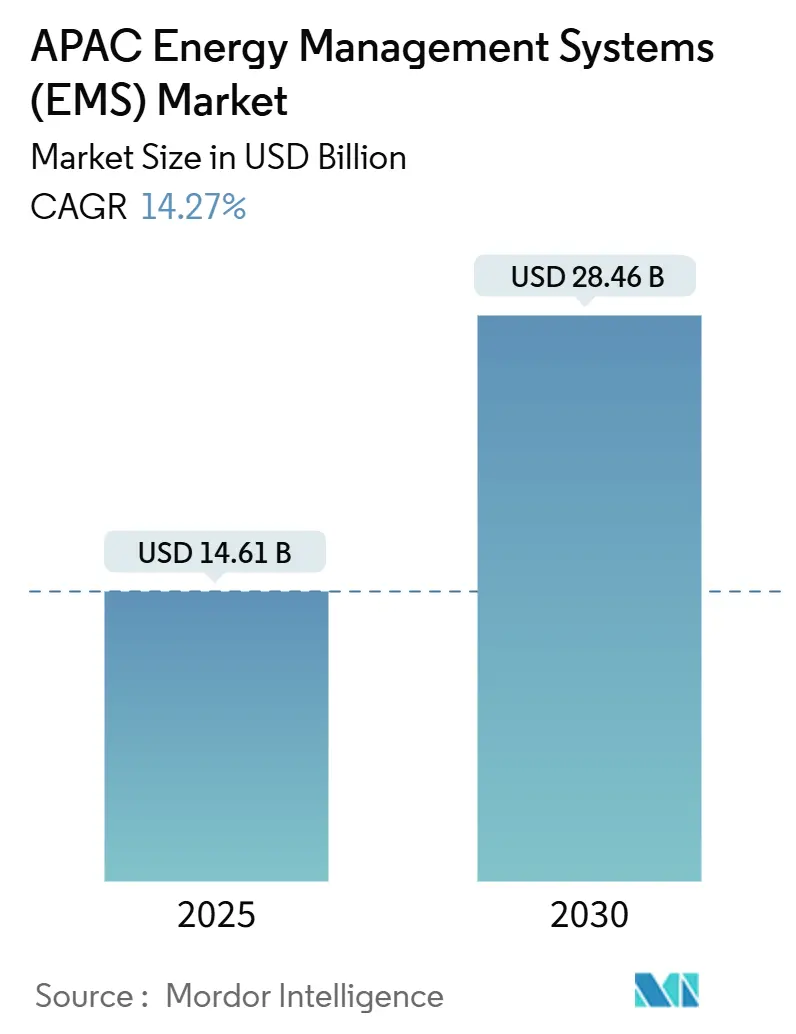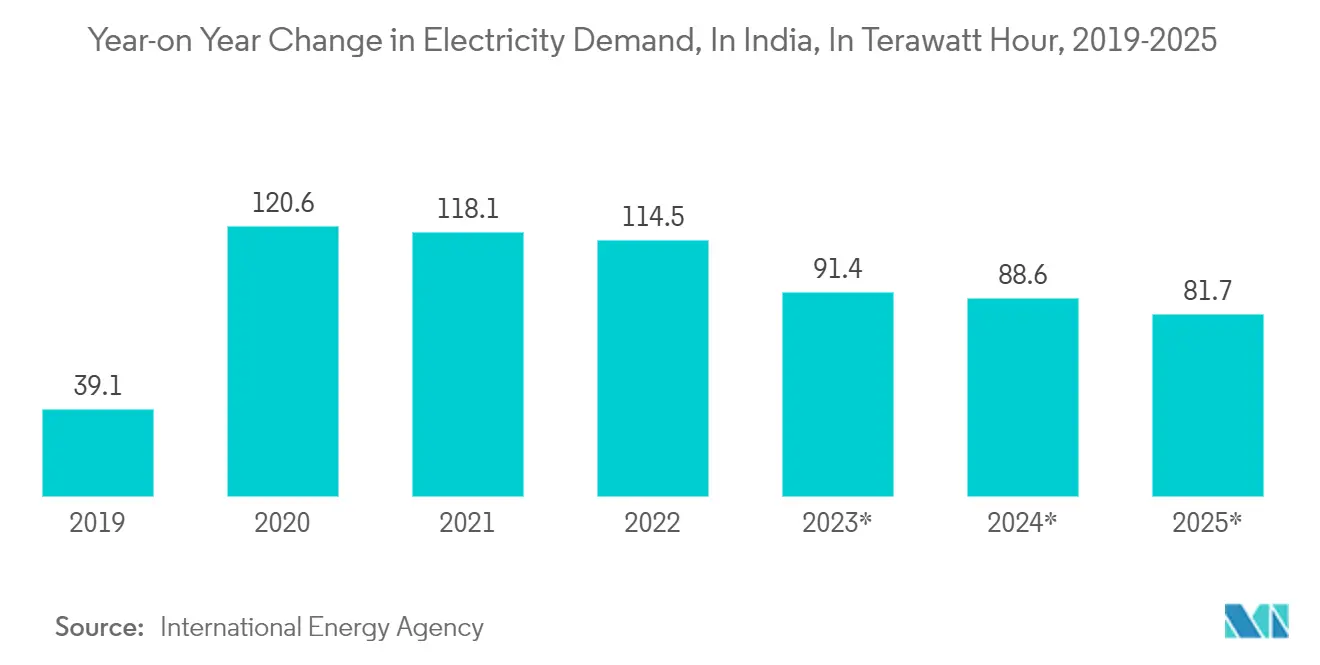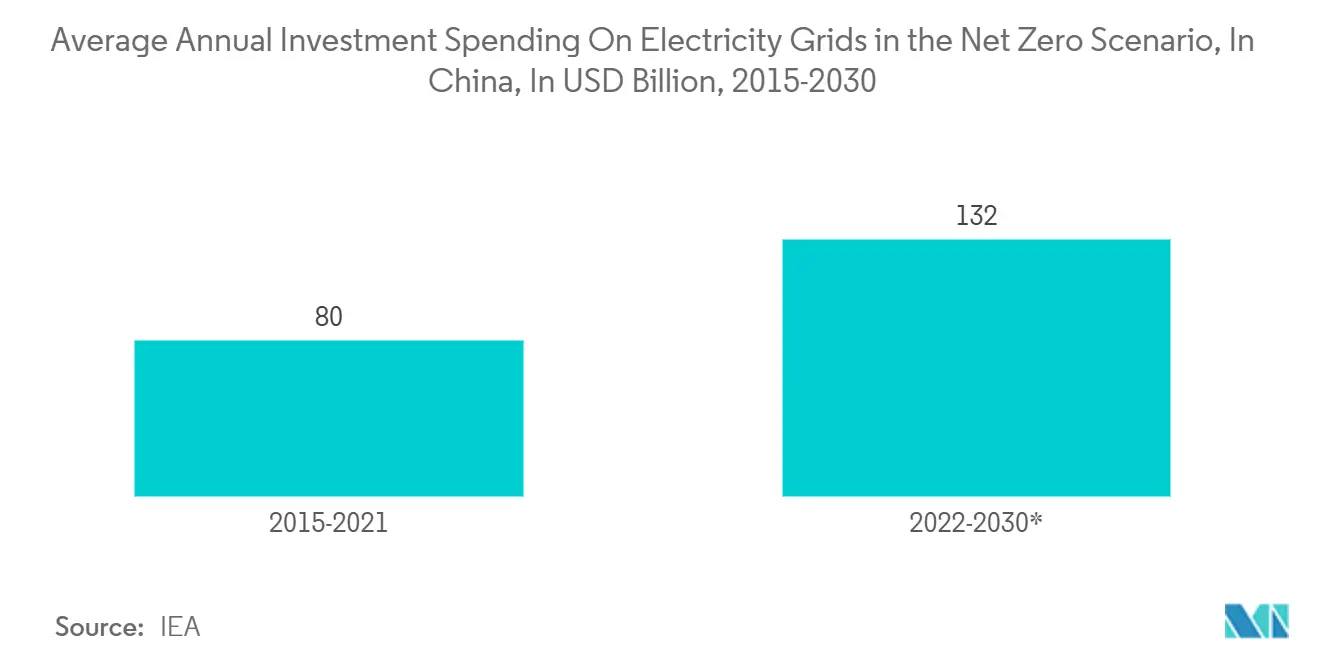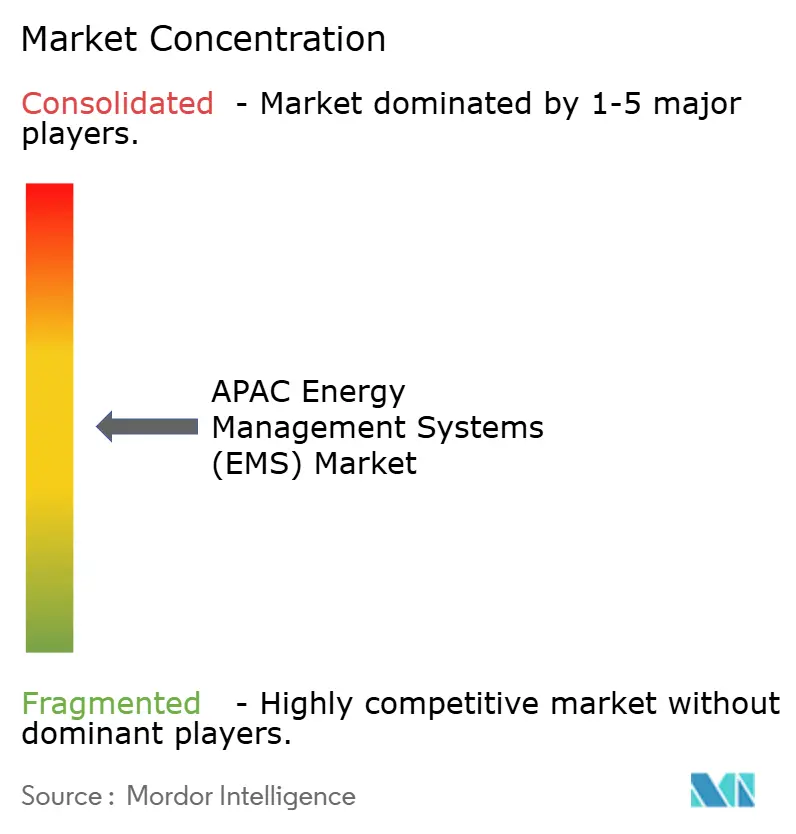
APAC Energy Management Systems (EMS) Market Analysis by Mordor Intelligence
The APAC Energy Management Systems Market size is estimated at USD 14.61 billion in 2025, and is expected to reach USD 28.46 billion by 2030, at a CAGR of 14.27% during the forecast period (2025-2030).
- Asia-Pacific has been the most rapidly industrializing over the last quarter-century. Energy management requirements and the growing emphasis on reducing utility costs continue to drive the adoption of APAC energy management systems (EMS). The majority of the large buildings in the region are equipped with these systems.
- Proactive measures taken by government organizations in the region to implement standards, such as ISO 50001 (energy-management-system standard) in the building sector, can stimulate the integration of EMS.
- Consequently, more opportunities for automation can now be found across small-to-medium buildings in the region. In Asia, households have grown exponentially over the last two decades. According to UN-Habitat Organization, the urban population in Asia is expected to grow by 50% by 2050, further opening up opportunities for the building and construction industry in the region.
- Governments across countries have been working hard towards decarbonization and are actively involved in setting limits for energy consumption. For instance, in June 2021, the Indian government took the initiative, such as Perform Achieve and Trade (PAT) Scheme to save energy to reduce CO2 emissions levels in the environment from establishment, industries, and by using energy appliances/equipment. The program provides mandatory targets for identified large units, and the surplus energy they save is issued as Energy saving certificates, which are tradeable instruments. Different companies and industries are assigned separate energy efficiency targets based on their potential for energy savings and energy consumption levels.
- NTELS, a Korean tech firm, developed a BEMS where energy data from heating, ventilation, and air conditioning (HVAC) systems were collected. Then, depending on their characteristics, the system identified the energy consumption patterns of buildings and created proper energy consumption plans. It also has forecasting and building operations monitoring features, which leads to optimizing energy efficiency in buildings. Such BEMS technology can transform the energy efficiency of buildings.
- The market growth is expected to be hindered due to high installation costs. Several small-sized and mid-sized organizations need to be able to deploy a complete high-tech and automated EMS system in industries or buildings as they require a high initial investment. The hardware components of the energy management system are much higher as compared to service and software components.
- Since the novel coronavirus has declared a pandemic, most businesses and factories have been closed due to several lockdowns imposed by governments, further hampering the growth of the Asia Pacific Energy Management Systems market. On the other hand, energy consumption in homes, as well as hospitals, has increased drastically. However, power and energy consumption has decreased overall, mainly due to the halt of manufacturing activity in China, Japan, and India. Given the government initiatives to reduce energy consumption, the region will likely provide opportunities over the forecast period.
APAC Energy Management Systems (EMS) Market Trends and Insights
HEMS (Home EMS) to Experience Significant Growth
- With the rapid improvements in technologies, like network communication, smart grid, bidirectional communication mediums, information infrastructures, energy conservation methodologies, and various techniques, home area networks (HANs) encountered a revolutionary change in multiple areas of power consumption domains, like energy conservation at consumption premises and electricity usage patterns.
- Due to the increasing concern about the efficient use of energy, there is an expanding focus on installing energy-saving devices in households. Energy management systems are cost-effective in all residential buildings, regardless of national energy prices, usage, and climatic factors. Thus they are increasingly being adopted in homes.
- Increasing investment in grid digitization by implementing advanced communications technologies will drive the growth of the residential energy management market. Over the next decade, China is investing USD 6 trillion in infrastructure as part of its urbanization development program. China and the economy, which have signed a cooperation agreement with China on the Belt and Road Initiative (BRI), are rising as a share of the world economy.
- Recently, there has been a significant surge in the development of connected, intelligent devices, such as smart meters, sensors, and smart thermostats, equipped in intelligent homes. These devices are experiencing advancements in power monitoring and display technologies. For instance, the Government of India planned to create 500 smart cities in a phased manner, with intelligent homes being the most critical entity of smart cities.

China is Expected to Hold Significant Share
- Over the years, Beijing has pursued an energy intensity target relative to GDP, allowing China to grow at a tremendous pace. However, just like the European Union, China has also put a cap on energy use by 2020. The Government in these regions is proactive in planning for smart meter installation.
- According to the World Green Building Council, China is the largest building construction market globally, with up to 2 billion square meters constructed annually, accounting for nearly half of new construction globally in the coming decade. It is also the world’s largest emitter of greenhouse gas emissions, which allows the country to invest in green buildings using energy management systems.
- Due to growing urbanization, people migrate from rural areas to big cities, increasing the demand for residential accommodations. Increasing construction activities in urban areas have led to higher energy consumption rates and pushed the global power grid to its limit, further fuelling the demand for the energy management systems market.
- In August 2023, Jinko Solar, the solar technology company, delivered a 430kWh energy storage system project in Zhejiang, China, with the company’s SunGiga (JKS-215KLAA-100PLAA), a liquid cooling commercial and industrial energy storage system.
- Jinko Solar’s SunGiga commercial and industrial energy storage system offers a modularized design with various battery capacity options from 200kWh to 2MWh. It is designed for applications requiring two to four hours of energy storage. Such initiatives by various companies in the region is expected to further support the growth of Energy Management Systems (EMS) Market in the Asia Pacific region.

Competitive Landscape
The Asia Pacific Energy Management Systems Market is moderately fragmented with the presence of various international players such as IBM, Honeywell, Schneider Electric, Rockwell Automation, and General Electric Company, among others. The companies in the market are launching products with the latest technological developments and are collaborating with various governments and organizations to increase their market share. Some of the recent developments are:
- January 2023 - Schneider Electric unveiled Schneider Home, a home energy management solution for homeowners seeking comfort, saving, and energy independence, at Consumer Electronic Show in Las Vegas. This solution includes a high-power solar inverter, a home battery for clean energy storage, an electric vehicle charger, connected electric light switches and sockets, and an intelligent electrical panel. The Schneider home app will control all these.
- January 2022 - Eaton Corporation announced the acquisition of Royal Power Solution, a U.S.-based manufacturer of high-precision electrical connectivity components used in energy management, electric vehicle, industrial and mobility markets. Through this acquisition, the company aims to enhance its ability to capitalize on electrification trends across aerospace, eMobility, and electrical businesses.
APAC Energy Management Systems (EMS) Industry Leaders
IBM Corporation
Rockwell Automation Inc.
General Electric Company
Schneider Electric SE
Honeywell International Inc.
- *Disclaimer: Major Players sorted in no particular order

Recent Industry Developments
- January 2025: VNT, a global powerhouse in power and energy solutions, is set to make waves at ELECRAMA 2025, happening from February 22nd-26th at the India Expo Mart, Greater Noida. With a commitment to driving energy efficiency and supporting global net zero goals, VNT will unveil its revolutionary Energy Monitoring Solution (EMS)—a next-gen suite designed to optimize energy consumption and fuel a sustainable future.
- July 2024: GreenPowerMonitor (GPM), a DNV company, has launched an advanced Energy Management System (EMS) designed specifically for renewable power plants. This new tool represents a significant leap forward in these facilities' operational efficiency, in sync with the global movement to increase renewable energy capacity.
APAC Energy Management Systems (EMS) Market Report Scope
Energy management systems help monitor and control energy consumption in industries, commercial facilities, and residential sectors. The data collected is presented intuitively, which helps make sound decisions to improve the building’s energy performance.
The Asia Pacific Energy Management Systems market is segmented by type of EMS (building EMS, industrial EMS, and home EMS), end-user industry (manufacturing, power and energy, it and telecommunication, and healthcare), component (hardware, software, and services) and country. The market sizes and forecasts are provided in terms of value in (USD) for all the above segments.
| BEMS (Building EMS) |
| IEMS (Industrial EMS) |
| HEMS (Home EMS) |
| Manufacturing |
| Power and Energy |
| IT and Telecommunication |
| Healthcare |
| Other End-user Industries |
| Hardware |
| Software |
| Services |
| China |
| India |
| Japan |
| South Korea |
| Rest of Asia Pacific |
| By Type of EMS (Energy Management System) | BEMS (Building EMS) |
| IEMS (Industrial EMS) | |
| HEMS (Home EMS) | |
| By End-User Industry | Manufacturing |
| Power and Energy | |
| IT and Telecommunication | |
| Healthcare | |
| Other End-user Industries | |
| By Component | Hardware |
| Software | |
| Services | |
| By Country | China |
| India | |
| Japan | |
| South Korea | |
| Rest of Asia Pacific |
Key Questions Answered in the Report
How big is the APAC Energy Management Systems Market?
The APAC Energy Management Systems Market size is expected to reach USD 14.61 billion in 2025 and grow at a CAGR of 14.27% to reach USD 28.46 billion by 2030.
What is the current APAC Energy Management Systems Market size?
In 2025, the APAC Energy Management Systems Market size is expected to reach USD 14.61 billion.
Who are the key players in APAC Energy Management Systems Market?
IBM Corporation, Rockwell Automation Inc., General Electric Company, Schneider Electric SE and Honeywell International Inc. are the major companies operating in the APAC Energy Management Systems Market.
What years does this APAC Energy Management Systems Market cover, and what was the market size in 2024?
In 2024, the APAC Energy Management Systems Market size was estimated at USD 12.53 billion. The report covers the APAC Energy Management Systems Market historical market size for years: 2019, 2020, 2021, 2022, 2023 and 2024. The report also forecasts the APAC Energy Management Systems Market size for years: 2025, 2026, 2027, 2028, 2029 and 2030.
Page last updated on:
APAC Energy Management Systems (EMS) Market Report
Statistics for the 2025 APAC Energy Management Systems (EMS) market share, size and revenue growth rate, created by Mordor Intelligence™ Industry Reports. APAC Energy Management Systems (EMS) analysis includes a market forecast outlook for 2025 to 2030 and historical overview. Get a sample of this industry analysis as a free report PDF download.



